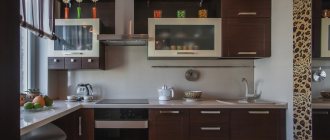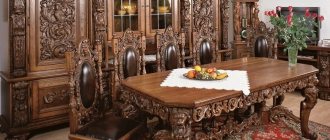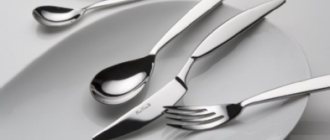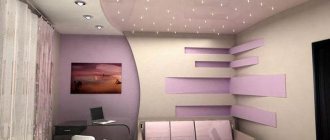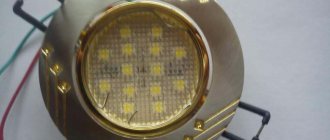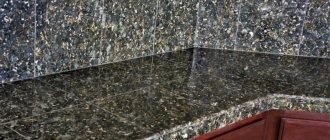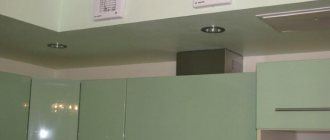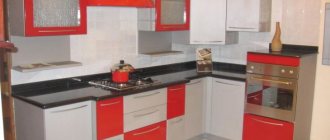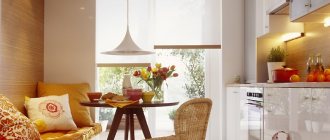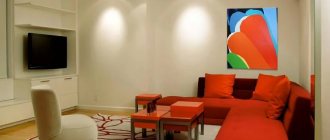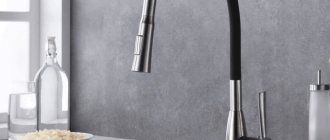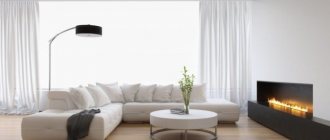Choosing high-quality lighting fixtures for the kitchen is an important process that is of considerable importance for arranging a harmonious interior. Currently, spotlights are very popular, they can perfectly complement the main chandelier, or even replace it completely.
An excellent solution to the problem of lighting in the kitchen are spotlights.
The convenience of staying in the kitchen, as well as the harmonious design of the room, will depend on how well such lamps are selected and installed. To make the right choice, you should listen to some expert advice.
Lamps for suspended ceilings
Location Features
Types of devices
Lamps used
Installation of ceiling models
Location: photos and diagrams
Lighting options
Lamps not only perform the function of lighting, but also decorate the room, giving it uniqueness and special comfort. When choosing lighting fixtures, take into account the general idea of the design, as well as the features of the surface to which they will be attached. Lighting in a kitchen with a suspended ceiling has its own nuances, which we will consider in the article.
Photo: Instagram @prinesibobra
Photo: Instagram @deluxe_od.com.ua
Photo: Instagram @migcomservice
Hanging lampshade
A lampshade hanging from the ceiling is a wonderful way to create accent and decorative lighting in a large or medium-sized kitchen with a high ceiling. Hanging lampshades are best combined with spot or perimeter lighting, but together with a chandelier they will look good only in a large kitchen.
2-3 lamps located above the table with wooden or made from special paper lampshades are characteristic of the Scandinavian trend that is fashionable today. In the case of a kitchen layout with an island (peninsula), they are also placed above the work area. They look, you see, stylish and cozy.
Among the pleasant options is the ability to adjust the length of the cord and a wide variety of lampshades that can be changed from time to time, bringing variety to everyday life.
An interesting solution is a cage lampshade, suitable for kitchens in a modern style. And an Edison light bulb hanging on a cord or decorative knots will highlight interiors in a loft or retro style.
Features of the location of lamps in a kitchen with a suspended ceiling
When choosing lighting, you need to take into account the features of stretch fabrics. They are made from PVC film or fabric. With constant heating above 60 degrees, the film may darken and melt. The fabric is more stable and can withstand temperatures up to 80 degrees. It is advised to adhere to several rules:
- choose lighting fixtures that do not heat up too much;
- choose incandescent lamps with a power of up to 60 W, and halogen lamps with a power of up to 30 W, while it is important to maintain a distance from the lighting fixture to the panel. It must be at least 30 cm;
- If possible, use LED and energy-saving varieties, since they hardly heat up during use.
Photo: Instagram @prinesibobra
Photo: Instagram @prinesibobra
Photo: Instagram @migcomservice
- Lighting
How to choose a chandelier for your interior: options for 8 popular styles
Organization of spot lighting
Spotlights
Most often, this type of lighting is implemented with spot LEDs, pendant units or spotlights. They are located above a specific location where you want to make an accent or highlight any decorative elements. The points can be used either individually or en masse; their number is limited only by the kitchen space and your personal wishes.
This lighting method is characterized by a convenient location, since spotlights do not take up much space, they fit well into any interior style. And in some situations they can be hidden in structural parts (stretch ceilings, in elements of kitchen cabinets). It is most advisable to use them for local lighting of functional areas.
Types of lighting fixtures
Based on their design, lighting fixtures are divided into four groups.
Chandeliers
They are still in demand, despite the emergence of more modern accessories. Manufacturers offer a good selection of models: from classically shaped lampshades to designer options made from unusual materials. To prevent the stretched panel from heating up, it is better to choose designs whose shades look down or to the side. It should be taken into account that the glossy surface reflects light. Therefore, chandeliers with shades will look good here. For film material, the distance to the heating zone is critical, so it is better to choose a longer chandelier suspension.
Photo: Instagram @_marina_ky
Photo: Instagram @_marina_ky
Photo: Instagram @_marina_ky
Spot
They are at the peak of popularity, which is not surprising: they do not heat up, have different mounting options, are durable and simply beautiful. Since the kitchen is often humid, it is better to choose models with a moisture-proof housing. To obtain bright or diffused light, you can choose transparent or frosted glass, respectively. And with the help of colored glass you can create unusual patterns on the surface. During installation, you can make electrical wiring to turn on the lights only in the areas needed at the moment. To calculate the required number of spotlights, you need to know the generally accepted lighting standard. It is 20 W per 1 sq.m of room.
Photo: Instagram @vgceiling
Photo: Instagram @mix_svet
Photo: Instagram @migcomservice
Spots
A variety of point models that are not built into the ceiling surface, but are attached to it or to the walls on a movable bracket. Due to their mobility, they create a directed beam of light. The control controller helps you adjust the intensity of the glow. These types are good for zoning a room, illuminating the desired part of it, or focusing attention on interior details. Spots can be single or complex, with several cartridges on one platform. If the spot itself is rather ascetic in appearance, then the platform can become an interior decoration.
Photo: Instagram @mix_svet
Photo: Instagram @prinesibobra
- Ceiling
How to make a stretch ceiling with lighting: useful tips and 72 photo examples
LED strips
The design looks like a flexible printed tape on which small LEDs, white or colored, are attached. Such ribbons run around the perimeter of the room, visually increasing its area. The reverse side of the tape is sticky, so it is easy to attach. The tape is connected to the network via a power supply. And controllers are used to control the brightness of the glow.
Photo: Instagram @migcomservice
Photo: Instagram @horizon_line_krd
- Lighting
9 ways to make your home more comfortable with LED strips
Decorative lighting
Unlike accent lighting, it is not a mandatory element of the kitchen lighting scenario. However, when used skillfully, it emphasizes the advantages of the interior and makes it original and memorable.
If you have a mosaic on your apron, add a three-color or monochrome LED strip to the bottom of the headset. It is flexible, so it can be pulled out easily even with corners. The emitted light will delicately highlight the glass or stone texture, creating a bizarre play of light and penumbra. Stunning intimate setting!
See also: Kitchen apron - 106 fashionable design ideas in real photos
If you stretch an LED strip along the perimeter between the ceiling and the set, you can achieve a useful optical effect of expanding the space. This is a good life hack for owners of modest-sized Khrushchev apartment buildings with very low ceilings.
The lower perimeter is used similarly. Below, the glow creates additional volume: the floor seems to float in space. In addition, this is a very beautiful and original design touch.
Use tape not only on the outside of the cabinets, but also on the inside. We have already written about the usefulness of this step, but here we propose once again to be convinced of the power of the aesthetics it generates.
Lamps used for lighting in the kitchen with a suspended ceiling
When choosing spotlights, you need to think about what lamps will be used in them. In our case, the following types are used.
- Incandescent lamps (base E27, E14) are loved by buyers despite other, more modern varieties. They provide a warm light that is pleasant to the eye, do not flicker, and are inexpensive. A serious disadvantage is their rapid and strong heating. Therefore, for pendant models, light bulbs with a power of up to 60 W are chosen. For built-in ones, it is better to choose other types.
- Halogen lamps are a more modern type of incandescent lamp. They shine brighter and last longer, but they cost more. Halogen lamps emit a light spectrum close to daylight. However, they also get very hot. For PVC canvases, it is recommended to choose lamps with a power no higher than 35 W.
- Luminescent ones do not heat up, therefore, they can be safely used next to film sheets. They can create both cold and warm radiation. This allows you to select a shade suitable for the interior. Energy-saving lamps are more expensive than incandescent lamps, but they consume five times less energy and last longer.
- LEDs are the leaders in all respects. They do not heat up, consume little energy, are bright and durable. Their glow spectrum is similar to daylight, and their small size allows them to be used in any design. The only negative is the rather high price compared to other types.
Organization of general light
General light
General lighting devices are designed to fill the entire space of a room with light flux. Therefore, they must provide a good level of illumination and a pleasant light. In most cases, these are the familiar central chandeliers that set the general background. However, the location and method of their placement should be chosen in accordance with local conditions.
If the room has a rectangular or square shape, you can get by with one central lighting device. The place for its installation is chosen in the middle, but inexperienced installers make a huge mistake - attaching a pendant chandelier in the center of the ceiling, without taking into account the space for kitchen cabinets.
In this case, after placing the upper cabinets, the chandelier will shift and the principle of light flux distribution will radically change. Therefore, the correct option would be to pre-mark the ceiling surface on the plan for filling the kitchen space.
How to find out where to install general lighting
The figure above shows two examples of installing lighting fixtures with and without kitchen units. If it is already hanging on the wall, measurements can be taken in full-scale form; if you are planning to install them, you need to start from the plan diagram.
If the kitchen space is narrow and long, then one lamp may not be enough to provide light to distant corners. Therefore, in such a design it would be more expedient to replace one ceiling chandelier with several at once, suspended in a row.
Main lighting in a long kitchen
As in the previous version, the lighting area should be taken without taking into account kitchen furniture. If your kitchen is not only long, but also wide, chandeliers can be hung in two rows.
Installation of ceiling lamps
Based on the shape of the structure and type of installation, they can be divided into three groups.
Hanging
Mounted on a hook in the ceiling. The chandelier has fasteners with which the structure is suspended. When installing, a hole is made in the canvas through which the suspension is pulled. It is recommended to choose large chandeliers for spacious rooms, while respecting the chosen interior style. Particular attention should be paid to the length of the fastening. Between the main ceiling and the stretched ceiling there is a space that will hide part of the suspension. It is important that the device is not too close to the stretched fabric.
Photo: Instagram @prinesibobra
Photo: Instagram @prinesibobra
Built-in
They consist of a housing, a light bulb with a diffuser and a mount. The housing is completely or partially recessed (built-in) into the ceiling plane. Its shape can be round, square or rectangular. There are models that illuminate only the space underneath (they are called downlights) and those that rotate in different planes, changing the direction of the beam.
Photo: Instagram @vgceiling
Photo: Instagram @swg_ru
The appearance of the device can be chosen to suit your taste: flat or with a convex shade in the form of a cone, ball, polygon or cylinder.
Photo: Instagram @zdes_svet
Photo: Instagram @zdes_svet
Photo: Instagram @zdes_svet
Photo: Instagram @zdes_svet
Overlay rings are decorated with pendants or decorative patterns. The models are ideal for illuminating a two-level upper structure. This way you can select one level or all at once.
Photo: Instagram @zdes_svet
Photo: Instagram @zdes_svet
Photo: Instagram @zdes_svet
Photo: Instagram @zdes_svet
Invoices
Installed using a platform on the ceiling canvas. The main selection criterion is lightness. Most often this type is represented by LED models. They are lightweight, yet they shine brightly and do not heat up. The design of their lampshades is varied. The platform can be stylized to resemble precious metals.
Photo: Instagram @divine_light.ru
Photo: Instagram @prinesibobra
Photo: Instagram @e.okna
- Lighting
How to remove a spotlight from a suspended ceiling and replace it with a new one
Multi-tube varieties
Installing spots with several reflectors is more profitable. Why? To install the wiring, several branches are not required; everything is brought to one place, where the power center of the entire structure will be. Spots are installed either on a flat area or on a bar.
The advantages are that several objects will be illuminated at once, the light will be brighter and more saturated, and the installation cost will be much lower than if you install several single-lamp lamps separately.
About choosing light bulbs
You can use a wide variety of lamps to illuminate your kitchen, but their type will largely determine both the quality of perception of the objects around you and the cost of maintaining the lighting fixtures.
The most commonly used types of lamps are:
- incandescent lamps - is a classic option, they create a luminous flux in the range of 2000 - 3000K - the warmest range of glow, but also consume the most electricity;
- a halogen lamp operates in the range from 3000 to 4000K, its electricity consumption is comparable to an incandescent lamp;
- fluorescent light bulbs - use the range from 4000 to 6000K, but have a significantly lower level of energy consumption for lighting;
- LED lamps are characterized by fairly wide temperature limits - from 3000 to 7000K and minimal power consumption.
To create a comfortable atmosphere in functional rooms, you should choose lamp models with a temperature from 3000 to 5000K; the rest will create a cold, unnatural glow.
Colorful temperature
The role of natural light
Since the cost of energy resources is quite high, no one neglects the opportunity to reduce their consumption. And using natural light coming from the window is the best opportunity.
The role of natural light
The main thing to consider is the size of the windows and their position relative to the cardinal points:
- with access to the north side - in this case, natural light will flow rather weakly, so it is very important not to interfere with it. It is advisable to use transparent curtains or blinds with the function of fully opening the window.
- with a southern location - here you will have an excess of lighting during the daytime, so you can use blinds, Roman blinds or roller blinds to control it.
- The eastern side is identical to the southern side, with the difference that the peak brightness will occur in the early morning, and during the day the light will be moderate.
- Windows facing west also require good sun protection, but only for the evening hours.
Note that if there is a tree in front of the window that blocks the horizon in summer, then the density of the curtains can be significantly reduced. Since in the summer, when solar radiation is most intense, the crown of the tree neutralizes most of the direct rays.
Care and potential problems
There is no need for much effort to care for spotlights. However, annual deep cleaning is required. It is advisable to wipe off dust at least once every three months.
Before cleaning, devices should be disconnected from the power supply. Lighting devices and panels are cleaned using napkins (cotton or linen) and an antistatic broom.
Glass surface cleaners are used to remove grease. If special chemicals are not available, use a regular soap solution. The cleaned surface is thoroughly wiped. About half an hour after finishing cleaning, you can turn on the light.
To care for different types of materials, it is better to use the most suitable products for a particular case:
- Glass surfaces - antistatic wipes or brushes.
- Plastic surfaces - antistatic brush.
- Metal elements - with a damp cloth, and then polished with a dry cloth.
- Wooden parts - soft bristle brush and polish.
Cleaning fixtures should not be ignored. Otherwise, a build-up of dirt, grease and soot will not only lead to an unsightly appearance of the lighting fixtures, but may also cause them to break. The contact may short-circuit, as a result of which you will have to repair the lamp or even replace it with a new one.
Installation
To perform installation work you will need the following set of tools and accessories:
- connection terminals;
- flat head screwdriver;
- crowns for metal or wood;
- construction knife for stripping conductors;
- electric drill;
- pliers;
- wire cutters;
- ladder.
Connection of lamps should be carried out taking into account the wiring diagram. First of all, install the lighting box. It is installed in such a way that it remains freely accessible in the future. Placing the box behind the covering material is not allowed. Next, a separate wire is connected from it to each lighting fixture. In this case, the conductors are placed in a corrugated pipe that performs a protective function.
If the installation of spotlights is carried out in a plasterboard structure, the work is performed as follows:
- First, they decide how to place each device on the ceiling. The location of the guides is taken into account, since the lamps should not rest on them.
- Using an electric drill with a hole saw, make a hole of the required size in the drywall. For square lamps, use an electric jigsaw to cut the hole.
- Pass the cable through the hole. You can work with wires only when the network is de-energized. To remove the cable from the hole, use a wire hook.
- Connect the cable brought out through the terminals (taking into account the color scheme). If LED fixtures are equipped with screw terminals for conductors, terminals will not be needed.
- Install the lamps in the holes and secure them with clamping springs.
- Light bulbs are screwed into lighting fixtures. Put on a decorative ring.
- Test the system for performance.
How to choose a spot?
For suspended ceilings, recessed types of lamps are preferred. In this case, the body of the structure remains behind the canvas, and the outer part is outside. This design is more aesthetically pleasing.
It is also important to pay attention to lamps for devices, since the stretch fabric does not tolerate high temperatures. A suitable and common option is energy-efficient LEDs that are not subject to heat. It is possible to use incandescent lamps that have a low power of 40 watts.
The photo shows built-in spots for tension fabric in the kitchen-living room design.
